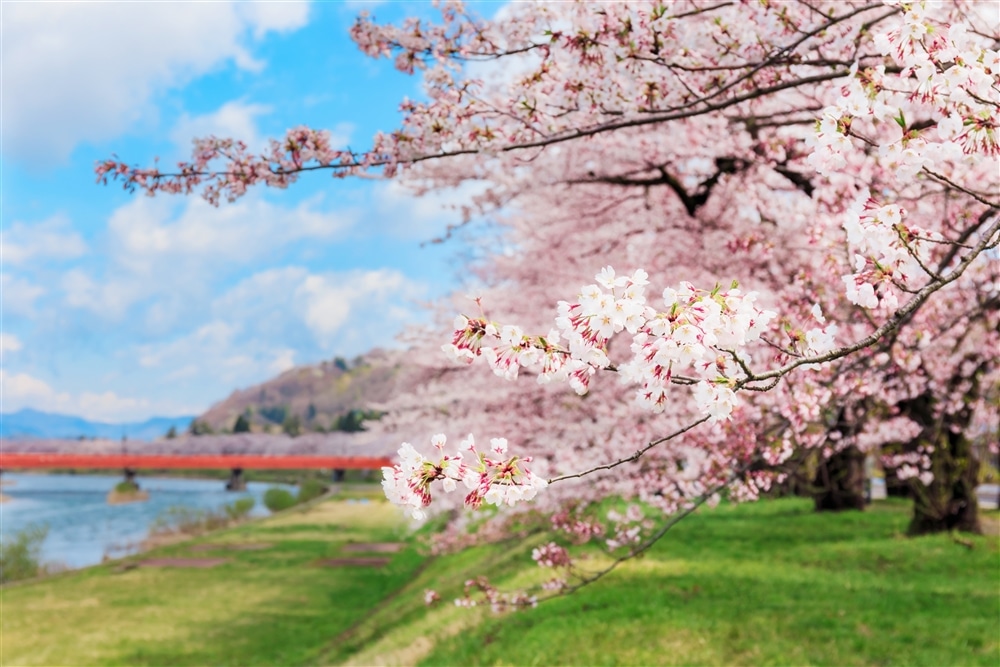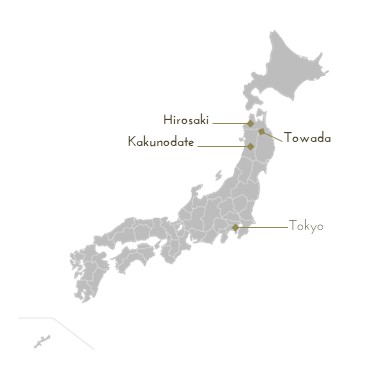

Day 1
From Hachinohe Station it is short drive to the Hakkoda Ropeway hop-on point. From here, take in the superb mountain views as the ropeway whisks you to the top of Mount Hakkoda (elevation 1,320 meters/4,330 feet) in 10 minutes. From the summit, enjoy panoramic vistas stretching as far as Shimokita Peninsula and Mount Iwaki.
Numerous trails are available for hikers of all levels, from a 30-minute walking path to a challenging four-hour climbing course.
As evening sets in, head back down the mountain and on to Towada Art Center for a special after-hours night event at this contemporary art museum. As well as numerous one-off exhibitions there are permanent collections by artists such as Yamagiwa Mitsuhiro, Ron Mueck and Yoko Ono. Be sure not to miss the Art Square and many outdoor installations, most of which are in the form of furniture. The streets around the museum are lined with cherry trees that are a riot of pink in spring.
Spend the first night in the luxury and comfort of Oirase Keiryu Hotel, situated in Towada-Hachimantai National Park close to the popular Oirase Gorge. Choose from a number of fabulous hot spring baths, all of which are fed by water that springs naturally from Mount Hakkoda. Follow a sumptuous dinner that showcases the exquisite tastes of Aomori Prefecture with a nightcap before retiring for a deep and peaceful sleep.
Day 2
Start the morning with a far from arduous 1.5-hour hike along the banks of the celebrated Oirase mountain stream, which snakes through the heavily forested Oirase Gorge and is the only outlet draining from Lake Towada. Known as “Waterfall Avenue,” this meandering rivulet becomes a frothing turbulence of white rapids where the more than 12 waterfalls cascade down from the walls of the gorge. The names of the waterfalls, such as Undying Falls, White Silk Falls, Sisters’ Falls and Sky Falls, are as evocative as the apple moss that adheres to the rocks like sponge. Oirase Gorge is a photographer’s dream made real.
Optional activities are available in the afternoon. These include canoeing on Lake Towada, cherry blossom viewing at Hirosaki Castle, a highly recommended visit to Neputa Village to see Tsugaru culture up close, including a taste of the famed Nebuta Festival, and a special tour of a Tsugaru painter's workshop.
Later, travel by private vehicle to Kai Tsugaru, where you will spend your second night. Enjoy apple-scented baths fed by the famous hot spring waters of Owani.
Day 3
Following a hearty breakfast, leave Kai Tsugaru by private vehicle and head to Odate in neighboring Akita Prefecture. Odate is recognized as the home of magewappa, a traditional steam-bent woodcraft that uses Akita cedar and cypress wood. Shibata
Yoshinobu Shoten has been making and selling beautiful magewappa products such as bento boxes and plates for two generations. Spend time browsing the beautiful products on sale or join a workshop and make your own one-of-a-kind magewappa plate. Take home a special memory of northern Japan.
Akita Prefecture is famous for its hardy dogs and beautiful women. Although no dogs are allowed, the privately chartered train that ferries you from Odate to Kakunodate comes complete with tatami-matted floors, zabuton floor cushions and exquisitely adorned maiko (apprentice geisha), who are there to keep you entertained throughout the 90-minute journey with dance, conversation and lots of locally produced sake.
At the former castle town of Kakunodate lose yourself in the ambience and architecture of the Edo era (1603-1868). Kakunodate’s samurai district encompasses two square kilometers of vintage residences, some of which are still lived in today. In spring, the tiled roofs and ornate walls radiate with the pink of the many weeping cherry trees in full bloom. Enhance your Edo experience by dressing up in a rental kimono and taking a short ride in a traditional hand-pulled rickshaw.
In keeping with the traditional theme of the day, your evening’s accommodation is at Wabizakura, an exclusive inn created around a 200-year-old thatched house. Each of the 10 luxurious suites has a distinct décor, private, free-flowing hot spring spa and terrace. Both Western- and Japanese-style rooms are available. Facilities include massage and oil treatment, a private-use open-air bath and a stargazing deck. Dinner at Wabizakura comprises organic ingredients fashioned into lavish dishes by a two-Michelin-starred Tokyo chef.
Day 4
Begin your last day of Tohoku springtime with a stroll along the Hinokinai River beneath a two-kilometer-long canopy of cherry blossom. The 400 trees along the river’s bank were planted in 1934 to mark the then emperor’s birthday. They are a resplendent reminder of pre-war imperial pageantry.
Delve further into Japan’s storied past at the Aoyagi Samurai Manor Museum, a sprawling and fascinating collection of Edo-era artifacts housed in numerous buildings that form one of Japan’s grandest samurai-era manor houses. Of particular interest is the magnificent Yukui Mon gate, a public declaration of the Aoyagi clan’s prestige. The L-shaped main house boasts an elegant thatched roof and three entrances, each used by a different social class. Other buildings house the armory, a number of samurai-related museums, a samurai experience booth and an antiques market.
At the very back of the compound is a studio and shop that showcases a woodcraft invented by Kakunodate samurai over 200 years ago. Kabazaiku takes advantage of cherry tree bark’s characteristic as a natural insulator against changes in humidity. Kabazaiku was mostly used for rounded storage containers such as those for tea and tobacco leaves. Today’s kabazaiku craftsmen create larger-scale wooden artworks intended mostly for display. Be sure to take home a kabazaiku souvenir as a reminder of your fours days spent among the cherry blossom and samurai vestiges of northeastern Japan.
A Shinkansen bullet train returns you to Tokyo in three hours.
For centuries, only the most intrepid of travelers made it to Tohoku, the six prefectures that form the northern tip of Japan’s main island. Today, the delights of Tohoku are accessible to anyone with a bullet train ticket and a love of adventure. Known for its mountains, lakes, hot springs, rich food and harsh winters, Japan’s north country is best visited during late spring, when the cherry blossom wave that sweeps across the archipelago finally catches up with this wild and unpredictable region. When viewed against the backdrop of the iridescent pink petals, the rough edges of Tohoku melt away to reveal a land steeped in innovation, history, craftsmanship and hospitality.